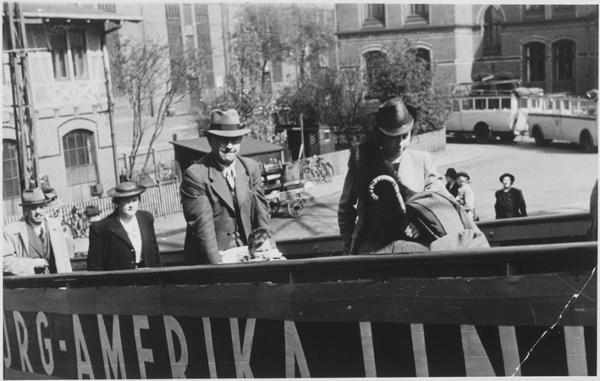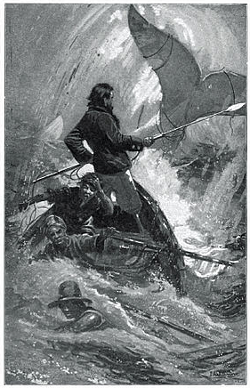“Faced with the choice between changing one’s mind and proving that there is no need to do so, almost everyone gets busy on the proof.” — John Kenneth Galbraith
Podcast Episode 91: Voyage of the Damned

In 1939, an ocean liner carrying 900 Jewish refugees left Nazi Germany seeking sanctuary in North America, but it was turned away by every nation it appealed to. In this week’s episode of the Futility Closet podcast we’ll follow the so-called “voyage of the damned” and the plight of its increasingly desperate passengers.
We’ll also discuss the employment prospects for hermits in Seattle and puzzle over the contentment of a condemned woman.
Point of Interest

The Austrian village of Jungholz is connected to the rest of the country by a single point, the summit of the mountain Sorgschrofen. The summit marks a “quadripoint,” a point that touches four distinct territories — here, Austria to the north and south and Germany to the east and west.
This raises some philosophical questions. Suppose a stubborn, infinitely skinny Austrian leaves Schattwald (in the south) to visit Jungholz at the same moment that an equally stubborn, infinitely skinny German leaves Bad Hindelang (in the west) to visit his grandmother in Pfronten (in the east). What happens? They can’t sidle past one another; the countries meet at a single, indivisible point. If neither will stand aside while the other passes, then the only solution I can see is for one to hop briefly onto the other’s shoulders.
Now suppose a border guard accosts them at this moment. The two occupy the same point on the Earth’s surface, yet one claims to be in Austria while the other is in Germany. Are they both right? And suppose that the lower man is killed by being jumped upon (he is very attenuated, after all). Which jurisdiction has authority over the crime scene? Who should judge the crime?
Further confusing borders: the Belgian town of Baarle-Hertog and, until recently, Cooch Behar in the Indian state of West Bengal.
(Thanks, Dan.)
Enlightenment

Biologist F.W. Went points out that the physical size of human beings was a critical factor in their mastery of fire. Any flame must maintain a certain size in order to sustain the ignition temperature of its fuel, and a wood or coal fire in particular radiates so much heat that it must maintain a fairly large critical mass in order to keep burning; a small fire will go out.
“Interestingly enough,” Went writes, “a wood or coal fire above the critical size produces just the right amount of heat to warm man in a cave, or a room, or a camping site. But ants or small rodents would have to keep too far away to make a fire economical, or rather, they would be unable to bring up enough wood to keep the fire going. Therefore in an ant society fire is not an economical possibility, and they have developed without its benefits, by operating only while outside temperatures are within the physiological range. Man on the other hand has been able to move into very cold areas by using fire.”
“Man, with his remarkable brain, developed the use of fire, but … only a creature of man’s size could effectively control that fire,” writes Peter S. Stevens in Patterns in Nature (1974). “It happens that a small campfire is the smallest fire that is reliable and controllable. A still smaller flame is too easily snuffed out and a larger one too easily gets out of control. Prometheus was just large enough to feed the flames and to keep from getting burnt.”
(F.W. Went, “The Size of Man,” American Scientist, 56:4 [Winter 1968], 400-413.)
The Qattara Depression Project

In 1957 the CIA proposed a novel way to bring peace to the Middle East: Flood Egypt’s Qattara Depression with seawater from the Mediterranean. The depression is below sea level and currently an arid waste; connecting it to the sea with giant tunnels or canals would transform it into a lagoon that would be renewed perpetually as the water evaporated, creating a continuous flow would produce endless hydroelectricity for the region.
The idea had begun with John Ball, English director of the Survey of Egypt, in 1927. In presenting it to Dwight Eisenhower, the CIA observed that the lagoon would be “spectacular and peaceful,” that it would “materially alter the climate in adjacent areas,” and that it would “provide work during construction and living areas after completion for the Palestinian Arabs.”
Eisenhower turned it down, but the project has never fallen entirely off the drawing board. In the early 1970s German hydraulic engineer Friedrich Bassler proposed detonating more than 200 nuclear bombs to excavate the canal, which would have meant displacing 25,000 evacuees. That proposal was turned down for ecological reasons, but another solution might yet be found.
See Atlantropa and Dam Ambitious.
Something New

The eminent tragedian [William Charles Macready] opened in Lear, our property-man received his plot for the play in the usual manner, a map being required among the many articles (map highly necessary for Lear to divide his kingdom). The property-man being illiterate, read ‘mop’ for ‘map.’ At night the tragedy commences; Macready in full state on his throne calls for his map, a ‘super’ noble, kneeling, presents the aging king a white curly mop. The astounded actor rushed off the stage, dragging the unfortunate nobleman and his mop with him, actors and audience wild with delight.
— Edmund Stirling, Old Drury Lane, 1881, quoted in Ralph Berry, ed., The Methuen Book of Shakespeare Anecdotes, 1992
A Pitched Battle

In The Book of the Harp (2005), John Marson mentions a musical oddity — in 1932, a committee devoted to equal temperament was so incensed at the Royal Schools of Music that it hauled them before London’s Central Criminal Court for obtaining money under false pretenses. From The Music Lover magazine, April 30, 1932:
There is a touch of knight errantry about the action of Lennox Atkins F.R.C.O., hon. sec. of the Equal Temperament Committee, in applying at Bow Street for process against the Associated Board of Examiners in Music on the grounds that they were not qualified to know whether the music was being played in tune or not, and that therefore their diplomas were valueless. It certainly savours of the ‘ingenious gentleman’ of La Mancha who tilted at windmills. The temperament question seems to have upon those who take it up an effect similar to that which temperament produces in a prima donna. They become, to say the least, unreasonable. Happily Mr Fry, the magistrate, decided that this was not a matter for a criminal court, so that Sir John B. McEwan and Sir Hugh Allen are not to be shot at dawn, as was at first feared.
McEwan headed the Royal Academy of Music and Allen the Royal College of Music at the time. I find a bit more in the Musical Times, June 1, 1932:
Candidates were allowed to pass off the tuner’s scale as their own, and to obtain certificates to which, the E.T.C. claimed, they were not in equity entitled. Every sound produced was the tuner’s and not the candidate’s. Famous examiners, such as the late Sir Frederick Bridge, had wrongly passed thousands of candidates in keyed instrument examinations. From the point of view of the E.T.C., the candidates were not really examined at all.
The magistrate added that if it was thought that the examiners’ knowledge was insufficient then civil proceedings might be undertaken.
“We have only once before heard of the Equal Temperament Committee — a long while ago — and we were, and are still, vague as to its aims,” noted the Musical Times. “We had imagined it to be a learned Society that met from time to time to exchange light and airy chat about ratios, partials, mesotonics, and other temperamental details. But it seems that it is a body with a Mission, though we are not clear what that Mission is. Judging from the Bow Street evidence, the Committee’s aim is to make ‘Every Musician His Own Tuner’ — which seems rather rough on real tuners.”
Fluke Encounter

How does Ahab find Moby-Dick? On more than 11 occasions in Melville’s novel we are given cardinal points, the accurate location of well-known cruising grounds, and changes in the ship’s direction as the Pequod follows a “zig-zag world-circle” in search of the great white whale. But we are never told how he hopes to find it, a task that seems flatly impossible.
In writing the book, Melville consulted maps, guidebooks, charts, and logbooks to lay out a route typical of a three-year whaling voyage. Ahab, as an experienced captain, might have known the migratory patterns of sperm whales, their feeding grounds, the ocean currents, and the locations of previous sightings. “But even with this seasoned knowledge, he is not guaranteed to track down an entire pod of whales, let alone one eccentric loner,” writes Eric Bulson in Novels, Maps, Modernity (2007).
Ishmael notes that “though Moby-Dick had in a former year been seen, for example, on what is called the Seychelle ground in the Indian ocean, or Volcano Bay on the Japanese coast; yet it did not follow, that were the Pequod to visit either of those spots at any subsequent corresponding season, she would infallibly encounter him there. … For as the secrets of the currents in the seas have never yet been divulged, even to the most erudite research; so the hidden ways of the Sperm Whale when beneath the surface remain, in great part, unaccountable to his pursuers.”
At one point Melville contends that the Pequod‘s circumnavigating route “would sweep almost all the known Sperm Whale cruising grounds of the world,” a conceit that the New York Albion called “more than sufficient motive” to justify the otherwise “intolerably absurd” idea of “a nautical Don Quixote chasing a particular fish from ocean to ocean.”
But even Ahab himself seems helpless in his task until the whale’s unexplained appearance at the novel’s end. In a dramatic address to the sun, he says, “Thou tellest me truly where I am — canst thou cast the least hint where I shall be? Or canst thou tell where some other thing besides me is this moment living? Where is Moby-Dick?”
Sundaram’s Sieve

In 1934, Indian mathematician S.P. Sundaram proposed this “sieve” for finding prime numbers.
In the first row of a table, write the arithmetic progression 4, 7, 10, …, with the first term 4 and a common difference of 3.
Copy these values into the first column, and then complete each row with its own arithemetic progression, with common differences of 3, 5, 7, 9 …, in successive rows.
Now, remarkably, for any natural number N > 2, if N occurs in the table then 2N + 1 is not a prime number, and if N does not occur in the table, then 2N + 1 is a prime number. (For example, 17 appears in the table, so 35 is not prime; 23 does not appear in the table, so 47 is prime.)
(From Ross Honsberger, Ingenuity in Mathematics, 1970.)
Figures
The word cliché was originally the French name for a printing plate that was prepared for convenience to print a commonly used phrase. The plates clicked as they were being used, and cliché is the past participle of clicher, a variant of cliquer, “to click.”
Interestingly, another name for this plate is stereotype.
